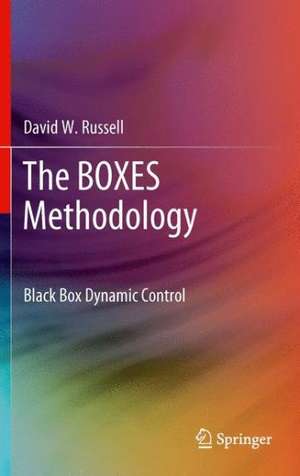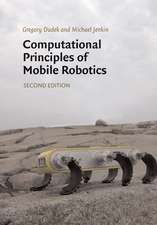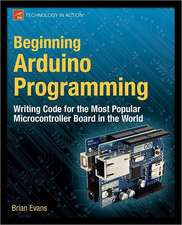The BOXES Methodology: Black Box Dynamic Control
Autor David W. Russellen Limba Engleză Paperback – 12 apr 2014
Michie and Chambers’ BOXES methodology created a black box system that was designed to control a mechanically unstable system with very little a priori system knowledge, linearization or approximation. All the method needed was some notion of maximum and minimum values for the state variables and a set of boundaries that divided each variable into an integer state number. The BOXES Methodologyapplies the method to a variety of systems including continuous and chaotic dynamic systems, and discusses how it may be possible to create a generic control method that is self organizing and adaptive that learns with the assistance of near neighbouring states.
The BOXES Methodologyintroduces students at the undergraduate and master’s level to black box dynamic system control , and gives lecturers access to background materials that can be used in their courses in support of student research and classroom presentations in novel control systems and real-time applications of artificial intelligence. Designers are provided with a novel method of optimization and controller design when the equations of a system are difficult or unknown. Researchers interested in artificial intelligence (AI) research and models of the brain and practitioners from other areas of biology and technology are given an insight into how AI software can be written and adapted to operate in real-time.
| Toate formatele și edițiile | Preț | Express |
|---|---|---|
| Paperback (1) | 730.95 lei 38-44 zile | |
| SPRINGER LONDON – 12 apr 2014 | 730.95 lei 38-44 zile | |
| Hardback (1) | 564.21 lei 38-44 zile | |
| SPRINGER LONDON – 14 mar 2012 | 564.21 lei 38-44 zile |
Preț: 730.95 lei
Preț vechi: 961.78 lei
-24% Nou
Puncte Express: 1096
Preț estimativ în valută:
139.86€ • 146.42$ • 115.73£
139.86€ • 146.42$ • 115.73£
Carte tipărită la comandă
Livrare economică 02-08 aprilie
Preluare comenzi: 021 569.72.76
Specificații
ISBN-13: 9781447160809
ISBN-10: 1447160800
Pagini: 248
Dimensiuni: 155 x 235 x 13 mm
Greutate: 0.36 kg
Ediția:2012
Editura: SPRINGER LONDON
Colecția Springer
Locul publicării:London, United Kingdom
ISBN-10: 1447160800
Pagini: 248
Dimensiuni: 155 x 235 x 13 mm
Greutate: 0.36 kg
Ediția:2012
Editura: SPRINGER LONDON
Colecția Springer
Locul publicării:London, United Kingdom
Public țintă
ResearchDescriere
Robust
control
mechanisms
customarily
require
knowledge
of
the
system’s
describing
equations
which
may
be
of
the
high
order
differential
type.
In
order
to
produce
these
equations,
mathematical
models
can
often
be
derived
and
correlated
with
measured
dynamic
behavior.
There
are
two
flaws
in
this
approach
one
is
the
level
of
inexactness
introduced
by
linearizations
and
the
other
when
no
model
is
apparent.
Several
years
ago
a
new
genre
of
control
systems
came
to
light
that
are
much
less
dependent
on
differential
models
such
as
fuzzy
logic
and
genetic
algorithms.
Both
of
these
soft
computing
solutions
require
quite
considerable
a
priori
system
knowledge
to
create
a
control
scheme
and
sometimes
complicated
training
program
before
they
can
be
implemented
in
a
real
world
dynamic
system.
Michie and Chambers’ BOXES methodology created a black box system that was designed to control a mechanically unstable system with very little a priori system knowledge, linearization or approximation. All the method needed was some notion of maximum and minimum values for the state variables and a set of boundaries that divided each variable into an integer state number. The BOXES Methodologyapplies the method to a variety of systems including continuous and chaotic dynamic systems, and discusses how it may be possible to create a generic control method that is self organizing and adaptive that learns with the assistance of near neighbouring states.
The BOXES Methodologyintroduces students at the undergraduate and master’s level to black box dynamic system control , and gives lecturers access to background materials that can be used in their courses in support of student research and classroom presentations in novel control systems and real-time applications of artificial intelligence. Designers are provided with a novel method of optimization and controller design when the equations of a system are difficult or unknown. Researchers interested in artificial intelligence (AI) research and models of the brain and practitioners from other areas of biology and technology are given an insight into how AI software can be written and adapted to operate in real-time.
Michie and Chambers’ BOXES methodology created a black box system that was designed to control a mechanically unstable system with very little a priori system knowledge, linearization or approximation. All the method needed was some notion of maximum and minimum values for the state variables and a set of boundaries that divided each variable into an integer state number. The BOXES Methodologyapplies the method to a variety of systems including continuous and chaotic dynamic systems, and discusses how it may be possible to create a generic control method that is self organizing and adaptive that learns with the assistance of near neighbouring states.
The BOXES Methodologyintroduces students at the undergraduate and master’s level to black box dynamic system control , and gives lecturers access to background materials that can be used in their courses in support of student research and classroom presentations in novel control systems and real-time applications of artificial intelligence. Designers are provided with a novel method of optimization and controller design when the equations of a system are difficult or unknown. Researchers interested in artificial intelligence (AI) research and models of the brain and practitioners from other areas of biology and technology are given an insight into how AI software can be written and adapted to operate in real-time.
Cuprins
Chapter
1:
Introduction.-
Part
I:
Learning
and
Artificial
Intelligence
(AI).-
Chapter
2:
The
Game
Metaphor.-
Chapter
3:
Introduction
to
BOXES.-
Chapter
4:
Dynamic
control
as
a
game.-
Part
II:
The
Trolley
and
Pole.-
Chapter
5:
Control
of
a
simulated
inverted
pendulum
using
the
BOXES
method.-
Chapter
6:
The
Liverpool
experiment.-
Chapter
7:
Solving
the
auto-start
dilemma.-
Part
III:
Other
BOXES
applications.-
Chapter
8:
Continuous
system
control.- Chapter
9:
Other
on/off
control
case
studies.-
Chapter
10:
Two
non-linear
applications.-
Part
IV:
Improving
the
Algorithm.-
Chapter
11:
Accelerated
learning.-
Chapter
12:
Two
advising
paradigms.-
Chapter
13:
Evolutionary
studies
research.-
Chapter
14:
Conclusions
Notă biografică
David
W.
Russell,
Ph.D,
C.Eng,
FBCS,
FIET,
FIMechE,
is
a
Professor
of
Electrical
Engineering
at
Penn
State
Great
Valley,
Pennsylvania,
USA.
His
research
interests
include:
applications
of
artificial
intelligence
(AI)
to
real-time,
poorly
defined
control
systems,
systems
engineering,
factory
information
systems,
philosophy
of
machine
intelligence,
and
chaos
theory
and
applications.
He
has
lectured
worldwide
for
many
years
and
has
over
30
papers
based
around
the
BOXES
methodology.
Textul de pe ultima copertă
Robust
control
mechanisms
customarily
require
knowledge
of
the
system’s
describing
equations
which
may
be
of
the
high
order
differential
type.
In
order
to
produce
these
equations,
mathematical
models
can
often
be
derived
and
correlated
with
measured
dynamic
behavior.
There
are
two
flaws
in
this
approach
one
is
the
level
of
inexactness
introduced
by
linearizations
and
the
other
when
no
model
is
apparent.
Several
years
ago
a
new
genre
of
control
systems
came
to
light
that
are
much
less
dependent
on
differential
models
such
as
fuzzy
logic
and
genetic
algorithms.
Both
of
these
soft
computing
solutions
require
quite
considerable
a
priori
system
knowledge
to
create
a
control
scheme
and
sometimes
complicated
training
program
before
they
can
be
implemented
in
a
real
world
dynamic
system.
Michie and Chambers’ BOXES methodology created a black box system that was designed to control a mechanically unstable system with very little a priori system knowledge, linearization or approximation. All the method needed was some notion of maximum and minimum values for the state variables and a set of boundaries that divided each variable into an integer state number. The BOXES Methodologyapplies the method to a variety of systems including continuous and chaotic dynamic systems, and discusses how it may be possible to create a generic control method that is self organizing and adaptive that learns with the assistance of near neighbouring states.
The BOXES Methodologyintroduces students at the undergraduate and master’s level to black box dynamic system control , and gives lecturers access to background materials that can be used in their courses in support of student research and classroom presentations in novel control systems and real-time applications of artificial intelligence. Designers are provided with a novel method of optimization and controller design when the equations of a system are difficult or unknown. Researchers interested in artificial intelligence (AI) research and models of the brain and practitioners from other areas of biology and technology are given an insight into how AI software can be written and adapted to operate in real-time.
Michie and Chambers’ BOXES methodology created a black box system that was designed to control a mechanically unstable system with very little a priori system knowledge, linearization or approximation. All the method needed was some notion of maximum and minimum values for the state variables and a set of boundaries that divided each variable into an integer state number. The BOXES Methodologyapplies the method to a variety of systems including continuous and chaotic dynamic systems, and discusses how it may be possible to create a generic control method that is self organizing and adaptive that learns with the assistance of near neighbouring states.
The BOXES Methodologyintroduces students at the undergraduate and master’s level to black box dynamic system control , and gives lecturers access to background materials that can be used in their courses in support of student research and classroom presentations in novel control systems and real-time applications of artificial intelligence. Designers are provided with a novel method of optimization and controller design when the equations of a system are difficult or unknown. Researchers interested in artificial intelligence (AI) research and models of the brain and practitioners from other areas of biology and technology are given an insight into how AI software can be written and adapted to operate in real-time.
Caracteristici
Suggests
a
generic
BOXES
coefficient
that
would
make
the
system
almost
completely
application-independent
Highlights potential flaws in the system
Describes how system flaws can be mitigated
Highlights potential flaws in the system
Describes how system flaws can be mitigated










